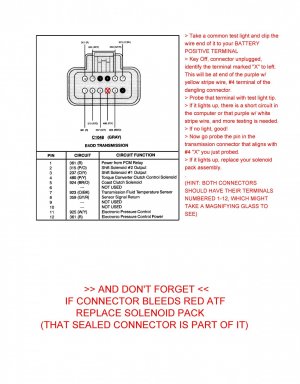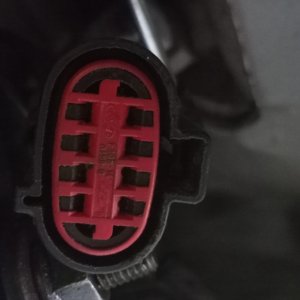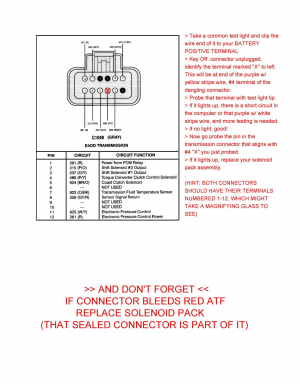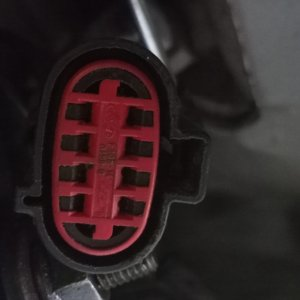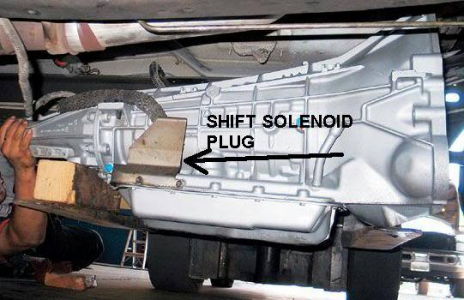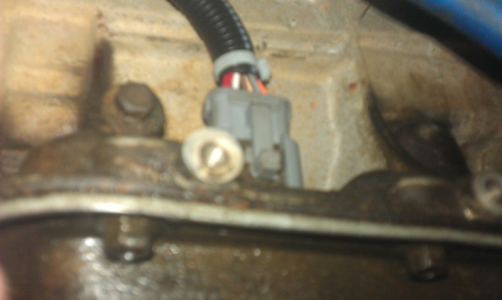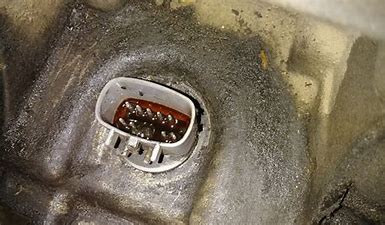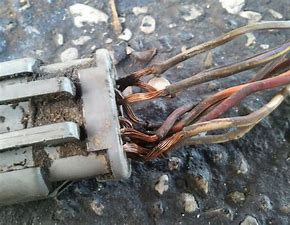A ramp would sure be nice.
Right? At least it's not a Mustang you have to crawl under.
Some answers in your quote:
Thank You, your pics and diagrams sure do help it make sense enough for me to test. Did I note that the trans man that said he replaced the trans put a new part on the side of the trans where that connector you speak of plugs in. If that switch is the neutral safety switch or transmission range sensor could it be out of adjustment? it does start ok in P or N.
No. Neutral Safety Switch/Range Selector switch is separate from ATC connector we're talking about. That is an "input" component that communicates information to the PCM, ie: it inputs gearshift selector position back to the PCM. If it was not adjusted right, your starter wouldn't crank in P or N properly.
The ATC connector we're playing with are "output" circuits. They connect components the PCM "outputs" commands to. In simpler terms, the solenoids are turned on and off with switches inside the PCM.
I will try to test the connector with a tester I know how to use after work if it don't rain, I am doing all this from just sliding under it on the ground.
Noticeably reduced fuel economy on longer highway drives). It that because it cuts out overdrive or something?
Sort of, but not overdrive.
TCC = Torque Converter Clutch.
The torque converter is the direct connection between engine and transmission. It makes that connection through viscous hydraulic inertia instead of a mechanical clutch used on a stick shift.
Think of TCC as a mechanical bypass to that hydraulic connection. When PCM turns on TCC, the torque converter becomes mechanically locked to the engine, literally converting from auto to manual transmission. This removes the stress the engine needs to overcome that
hydraulic inertia, the engine relaxes, and fuel economy improves dramatically.
"Clutch" is the key word in TCC, and "lockup" the key action the TCC Solenoid delivers.
The computer commands TCC on only at relaxed cruising speeds in third or fourth gear, relieving that stress and reducing engine RPM, which improves fuel economy.
From that context, that it converts an automatic to a stick shift, consider if it stayed locked on when you come to a stop. It would be just like rolling to a stop in a stick shift truck without pushing the clutch in. The engine would stall, right?
Your short circuit is substituting a full-time, constant command to the TCC lockup solenoid. When placed in gear, it's like dumping the clutch pedal in gear, at a stop with brake on. Instant stall.
With our tests, we're trying to figure out why your clutch isn't connected to the pedal anymore.

